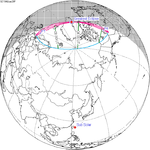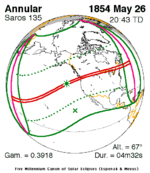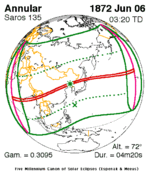Solar_eclipse_of_July_20,_1944
Solar eclipse of July 20, 1944
20th-century annular solar eclipse
An annular solar eclipse occurred on Thursday, July 20, 1944. A solar eclipse occurs when the Moon passes between Earth and the Sun, thereby totally or partly obscuring the image of the Sun for a viewer on Earth. An annular solar eclipse occurs when the Moon's apparent diameter is smaller than the Sun's, blocking most of the Sun's light and causing the Sun to look like an annulus (ring). An annular eclipse appears as a partial eclipse over a region of the Earth thousands of kilometres wide. Annularity was visible from British Uganda (today's Uganda), Anglo-Egyptian Sudan (the part now belonging to South Sudan), British Kenya (today's Kenya), Ethiopia, British Somaliland (today's Somalia), British Raj (the part now belonging to India), Burma, Thailand, French Indochina (the parts now belonging to Laos and Vietnam), Philippines, South Seas Mandate in Japan (the part now belonging to Hatohobei, Palau) the Territory of New Guinea (now belonging to Papua New Guinea).













































